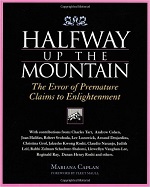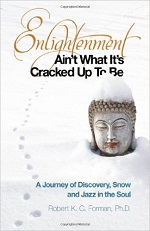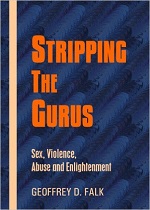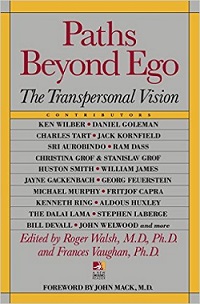|
TRANSLATE THIS ARTICLE
Integral World: Exploring Theories of Everything
An independent forum for a critical discussion of the integral philosophy of Ken Wilber
 Since 1990 Gary Stogsdill has been a faculty member at Prescott College where he currently teaches courses in humanistic mathematics, science appreciation, and wisdom studies. He has a blog called " Pursuing Wisdom Now", which features articles on contemporary spirituality.
A Critique of
Perennialism
Problems with Enlightenment,
Gurus, and Meditation
Gary Stogsdill
Introduction
But I was still the same unenlightened person, except now with the added problem of feeling special.
Perennial philosophy, also called perennial psychology or simply perennialism, is grounded in the generous belief that all human attempts toward a deeper understanding of the mysteries of life, including religions and other wisdom traditions, are ultimately the same path. In its naïve version, perennialism teaches that “all religions say the same thing,” which is clearly an overreach according to what the scriptures actually say. In its more thoughtful versions, perennialism teaches a range of perspectives including “all religions reflect a shared human need,” “mystical experiences reveal the same deeper reality,” and “the spiritual goal of human life is the same for all.”
This essay explores the version of perennialism that was popularized in the second half of the 20th century as “the spiritual path” and that formed the core of most New Age approaches to spirituality. This version is rooted in ancient philosophies originating in India—including Samkhya, Yoga, Vedanta, and in some cases Buddhism—and was first brought to America in 1893 by Swami Vivekananda who founded the Vedanta Society the following year. Then in 1920 Swami (later Paramahansa) Yogananda arrived to teach the “science of religion” that results in the universal goal of self-realization or enlightenment. Yogananda's widespread success paved the way for a seemingly endless string of gurus arriving from the East to add their own distinctive harmony to the chorus, an influx that crescendoed in the 1960s and 1970s. Some of the better-known names include Krishnamurti, Maharishi Mahesh Yogi, Swami Bhaktivedanta, Yogi Bhajan, Swami Rama, Yogi Amrit Desai, Swami Satchidananada, Swami Muktananda, Chogyam Trunpa, Rajneesh, Ammachi, and Sathya Sai Baba (who never traveled to the West but did exert an influence here).
Aspects of this version of perennialism found their way into the influential writings of Aldous Huxley, Alan Watts, Ram Dass, Deepak Chopra, Ken Wilber, and others, as well as into the popular offerings of the New Age movement. As a result, a significant number of the general population continue to hold beliefs that derive from perennialism. The intention of this essay is to critique the following teachings of this version of perennialism:
- The purpose of human life is enlightenment, an attainment that can be described as union of our human mind with Big Mind or God, or as Ken Wilber put it, “Men and Women can grow and develop (or evolve) all the way up the hierarchy to Spirit itself” (Walsh and Vaughan, Paths Beyond Ego, p. 215).[1]
- The way to attain enlightenment is through a disciplined practice of meditation under the guidance of a guru, one who has already achieved this ultimate state of consciousness.
Problems with Enlightenment
The most compelling aspect of this version of perennialism, which I will hereafter simply refer to as perennialism, is the promise of enlightenment, or evolving “all the way up the hierarchy to Spirit itself” (Wilber). Accordingly to perennialism, not only have many historical and contemporary figures attained this exalted state, but all the rest of us, perhaps after many lifetimes, are destined to become enlightened as well. It is the one and only purpose of human life, indeed the purpose of creation itself.
This teaching of perennialism brings up the first problem with enlightenment: it is the very definition of anthropocentric, “regarding humankind as the central or most important element of existence” (The New Oxford American Dictionary). Enlightenment implies that humans are special and superior to any other living beings. Of course it's natural to think this way, just as it was natural for each ancient society of humans to think that they were better than other groups of humans, an unfortunate tendency that persists to this day as prejudice. But the ancestors of all of us were just another clan of primates struggling to survive. That we human primates have achieved world dominance does not make us spiritually superior to other living beings such that the purpose of everything should be our own individual enlightenment.
And this brings up the second problem with enlightenment: it is all about an individual attainment and not about the greater good of the human and natural communities that make our individual lives possible. Enlightenment offers nothing toward a sustainable future for humans and planet earth beyond the freedom from suffering that individual humans allegedly achieve through their own attainment of enlightenment. Spirituality is often considered to be, in no small part, about growing beyond our selfish and self-centered tendencies, yet enlightenment appears to be the ultimate expression of self-centeredness.
The third and perhaps most troubling problem with enlightenment is that nobody can seem to agree on what it actually is. If enlightenment is truly the purpose and destiny of all human life, then those who attain enlightenment should describe it the same way, or at least in similar ways. Mariana Caplan wrote an intriguing book, Halfway up the Mountain: The Error of Premature Claims to Enlightenment, which explores what most of the Western spiritual teachers in the late 1990s, many of them believed to be enlightened, had to say about enlightenment. Along the journey of 522 pages of text, we learn from these spiritual teachers that enlightenment may be as simple as “a relaxed mind” (p. 40) or “the realization that you know nothing” (p. 45) or “freedom from the spiritual path” (p. 48). Remarkably, we also learn that those who are enlightened “suffer immensely” (p. 52), that those who are enlightened “will always be making mistakes” (p. 454), that “enlightenment is only the beginning” (p. 483), that “anybody who is enlightened is kind of ordinary” (p. 488), and finally Dr. Caplan's own conclusion in the very last paragraph that enlightenment “is nothing, non-existent, an empty term used by those who aspire toward something beyond the ordinary….” (p. 521).
Other authors have attempted to describe their own state of enlightenment. For example, Ken Wilber refers to his intermittent state of nondual awareness in One Taste and suggests in Kosmic Consciousness (as quoted in Jim Andrews' Integral World essay “Ken Wilber on Meditation: A Baffling Babbling of Unending Nonsense”) that when this state is permanent he will have attained full enlightenment, which we previously learned means that Wilber believes he will have evolved “all the way up the hierarchy to Spirit itself” (Walsh and Vaughan, Paths Beyond Ego, p. 215). In contrast, Robert Forman wrote a refreshingly humble book, Enlightenment Ain't What It's Cracked Up to Be, and suggests that we have drastically overblown enlightenment because his own enlightenment is pretty ordinary and didn't even stop him from shoplifting in his younger days.
My research agrees with Dan Millman's conclusion that “even in the spiritual traditions, a hundred different teachers give a hundred different descriptions [of enlightenment], ranging from 'the ultimate realization' to 'nothing special'” (Everyday Enlightenment, p. 336). This third problem with enlightenment renders the concept, or any similarly worded concept, virtually useless as a description of the purpose of human life.
Problems with Gurus
Given that the enlightened beings themselves cannot agree on what it is they have achieved, how can we evaluate their attainment of enlightenment? Certainly not by taking their word for it. We cannot evaluate the validity of what's inside someone's mind, even if they speak or write eloquently and convincingly about it. We can only evaluate the behavior of those claiming enlightenment, and in this case we would look for extraordinarily ethical behavior. Support for this approach to evaluating enlightened beings comes from the claims of perennialists themselves. For example, Roger Walsh and Frances Vaughan state: “After transpersonal maturation occurs, ethical behavior is said to flow spontaneously as a natural expression of identification with all people and all life” (Paths Beyond Ego, p. 48).
This approach to evaluating enlightened beings, or gurus, requires us to focus on those who have lived recently because it would not be possible to separate myth from fact for historical figures, where eye-witness accounts of flawed behavior would be carefully censored from the official hagiography. Investigating the lives of recent gurus reveals a painfully clear pattern: ethical behavior on the part of gurus does not often flow spontaneously or in in any other manner. Geoffrey D Falk's stunning expose, Stripping the Gurus: Sex, Violence, Abuse and Enlightenment, reveals deeply disturbing behavior on the part of a majority of the well-known gurus of the past 100 years, behavior that includes various forms of abuse and sexual misconduct.
One could easily be tempted from the information in Falk's book to conclude that the perennialist path, far from giving us paragons of extraordinarily ethical behavior, actually produces unethical behavior on the part of gurus. Why would this seem to be the case? Perhaps partly because the role of guru attracts those who are already narcissistic, but probably to a greater extent because of the simple fact that power often corrupts. Any one of us could believe that we are enlightened and start out as a guru with the best of intentions, only to become ensnared in our own shadowy behavior made possible by having power over others.
What can definitely be concluded is this: given the problems with gurus as revealed in Falk's book, there is no tangible evidence whatsoever to suggest that enlightened beings are any better as humans than the rest of us. And there is plenty of evidence to suggest that we place ourselves under the guidance of a guru at our own risk.
Problems with Meditation
The difference between Forman, Wilber, and me is that I understood these states to be merely what my mind was doing as a result of extensive meditation.
Those who are devoted to the version of perennialism discussed in this essay often suggest that no one is qualified to evaluate perennialism without having lived the process and experienced the altered states of consciousness that accompany extensive meditation and other practices. Here again are Roger Walsh and Frances Vaughan: “The ability to appreciate and understand transpersonal experiences, as well as their associated disciplines and life-styles, may depend on the extent of one's experience of these altered states….Undertaking practices to cultivate these experiences may be necessary for understanding them” (Paths Beyond Ego, p. 9).
I don't agree with this logic because it's similar to suggesting that only a practicing Scientologist is able to understand, and therefore evaluate, Scientology. I think the opposite may be true: we need those who have not drunk the Kool-Aid to evaluate the claims of those who have. However, I will begin this section on meditation by disclosing my own experience because it may add credibility in the eyes of some.
I spent 24 years, from ages 22 to 46, practicing meditation for three to four hours each day with longer weekly meditations. This meditation was supplemented with other spiritual practices under the guidance of a guru. Yes, I experienced some of the altered states of consciousness that are coveted by perennialists. No, that did not make me enlightened, which is why I left the perennialist path 18 years ago.
I experienced some of the states described by both Robert Forman in Enlightenment Ain't What It's Cracked Up to Be and by Ken Wilber in One Taste: the silent witness state where a part of the mind is always watching everything, which tends to give the illusion of things not being real as though waking life is a dream or a movie; the nondual state where a level of awareness is present constantly even when the rest of the mind is asleep; the state of absorption where the mind feels that it is one with whatever it observes, to the point that “I” seems to disappear and become the reality that's external. The difference between Forman, Wilber, and me is that I understood these states to be merely what my mind was doing as a result of extensive meditation practice, and not superior perceptions of ultimate reality. Anyone who has experimented with hallucinogens knows very well how altering brain function can bring unusual states of mind. The altered states of consciousness from meditation were, to me, no more indicative of a higher reality than seeing psychedelic patterns on an LSD trip. Admittedly, these altered states were captivating, and I definitely felt special for a while. But I was still the same unenlightened person, except now with the added problem of feeling special.
I also experienced another state of consciousness that needs to be described in more detail. One of the meditation techniques I practiced was intended to bestow “the bliss of union with God.” After years of growing more proficient in this technique, one day during practice I rocketed into ecstasy and stayed there for eight months. No matter what I did, I constantly felt indescribable bliss. I couldn't sleep; instead I would just lie down for a few hours each night and continue to experience bliss. I did not care at all about what happened in daily life; I was completely fulfilled by and focused on ecstasy every moment of every day until eight months later when this experience stopped just as abruptly and unexpectedly as it began.
I then felt a constant pain in my forehead, could no longer do that particular technique because it made the pain unbearable, and could think of nothing except what I had lost. For at least a year I was in a continuous state of depression and would have done almost anything to get back my previous experience of bliss. Several years would pass before I fully got over it and could enjoy life again. The parallels to drug addiction almost don't need to be stated. I'm convinced that this technique had altered my brain chemistry, as occurs with the euphoria of drug use. Just as drug addiction can easily destroy a healthy life, I lost all interest in any of the normal pursuits of life because the bliss was so captivating. Also like drug addiction, with the loss of euphoria came withdrawal symptoms, and I wanted nothing more than to return to that state of bliss.
 Meher Baba in 1945
Meher Baba in 1945
The technique that caused this experience originated in India where part of their cultural heritage includes “God-intoxicated saints,” some of whom lose the ability of normal human functioning because of being “blissed out” all the time. Some even need to be fed and cared for by their disciples. One of India's prominent 20th century gurus, Meher Baba, made it an emphasis of his life's work to seek out these masts, as he called them—which literally means “intoxicated”—and help them learn to function as normal humans again. I was saved from ruining my life during those eight months of ecstasy only because I tend to be a creature of habit, doing pretty much the same thing at the same time each day, so I was able to continue functioning by sheer force of habit.
This experience of mine highlights two of the problems with contemporary research into meditation. One is that most researchers make the mistake of assuming that all meditation is pretty much the same thing. To the contrary, meditation techniques range from very simple practices like repeating a mantra to very complex pranayama practices that involve breath control and energy movement. I'm convinced from my own experience that the latter techniques are capable of altering brain chemistry and function in ways similar to powerful drugs. Why aren't meditation researchers investigating the potential dangers of these techniques in an effort to keep up safe? Can it be for the simple reason that books with a title like How Meditation Can Harm You would sell much less than books with exaggerated titles like How Enlightenment Changes Your Brain?
The other problem with contemporary research into meditation is that many researchers are believers in meditation themselves and only want to find positive things to say about meditation, steering carefully away from indications of negative effects. Jim Andrews' excellent essay “Ken Wilber on Meditation: A Baffling Babbling of Unending Nonsense” at the Integral World website mentions TM studies that may point toward negative effects of long-term meditation practice, yet the researchers themselves ignored these indications, and Ken Wilber seems to have tried to dismiss these indications. A refreshing exception to this problem is the recent book The Buddha Pill: Can Meditation Change You? by Dr. Miguel Farias and Catherine Wilholm. This book includes an eye-opening chapter titled “The Dark Side of Meditation” where the authors conclude: “The unrealistically positive ideas associated with meditation only make people more vulnerable to either the adverse psychological effects or its enlightened-amoral teachers” (pp. 175-6).
I directly experienced this problem with meditation research a few years ago when I mentored a graduate student whose thesis involved a well-designed study of the effects of meditation and other practices within her own perennialist path. One result of this study was a highly significant statistical correlation between length of time practicing and negative psychological indicators. In other words, the longer the devotees on her path had been doing daily meditation and other practices, the less psychologically healthy they seemed to be. I was curious how this student would interpret findings that suggested her path could possibly have negative consequences. She skillfully sidestepped the obvious conclusion by saying that the longer we are on the perennialist path the more spiritual challenges we face because we are getting closer to enlightenment. Somehow the negative psychological indications were interpreted in a positive light as showing the effectiveness of her path.
The human mind can do exceptional things, and I'm convinced that serious, long-term meditation is indeed a journey into the largely uncharted depths of our unconsciousness mind. However, my own experience suggests that the altered states discovered therein cannot be equated with a higher reality or Spirit, and therefore we do not by virtue of meditation evolve “all the way up the hierarchy to Spirit itself” (Wilber in Walsh and Vaughan, Paths Beyond Ego, p. 215). Further, there are indications of possible psychological decline with extensive meditation as well as harm from altered brain chemistry and function with some meditation techniques.
Final Thoughts
These are not small problems; each one is substantial, and collectively they indicate the likelihood that perennialism is a self-centered dead end.
Some early clans of humans no doubt owed their survival, in part, to those brave scouts who would explore far beyond the clan's territory and return with knowledge of promising lands to migrate toward as well as lands to avoid because of potential harm. Those pioneers of early human society would point the way toward a better future for younger generations. Today those of us who explore unusual territories of how to live, including perennialism, have a similar obligation to report back to our larger community for the benefit of younger generations.
My own exploration and research reveals problems with perennialism: the blatant anthropocentrism and individualism of enlightenment, the lack of any agreement among those who are supposedly enlightened as to what enlightenment actually is, disturbingly unethical behavior on the part of a majority of well-known recent gurus, and indications that extensive meditation may correlate with psychological decline and that some techniques of meditation may harmfully alter brain chemistry and function. These are not small problems; each one is substantial, and collectively they indicate the likelihood that perennialism is a self-centered dead end with potentially serious dangers along the way. I definitely want younger generations to keep alive a healthy curiosity to explore the mysteries of life, but perennialism is not the ticket to a Promised Land of oneness with Spirit.
Notes
[1] Section Nine: The Philosophy of Transcendence, Chapter 35: The Great Chain of Being, 1993, p. 215. This chapter is also included in: Ken Wilber, The Eye of Spirit: An Integral Vision for a World Gone Slightly Mad, Shambhala, 1997 (FV):
The central claim of the perennial philosophy is that men and women can grow and develop (or evolve) all the way up the hierarchy to Spirit itself, therein to realize the "supreme identity" with Godhead—the ens perfectissimum toward which all growth and evolution yearns. (Chapter 1: The Spectrum of Consciousness: Integral psychology and the Perennial Philosophy, p. 39)
|
 Since 1990 Gary Stogsdill has been a faculty member at Prescott College where he currently teaches courses in humanistic mathematics, science appreciation, and wisdom studies. He has a blog called "Pursuing Wisdom Now", which features articles on contemporary spirituality.
Since 1990 Gary Stogsdill has been a faculty member at Prescott College where he currently teaches courses in humanistic mathematics, science appreciation, and wisdom studies. He has a blog called "Pursuing Wisdom Now", which features articles on contemporary spirituality.





